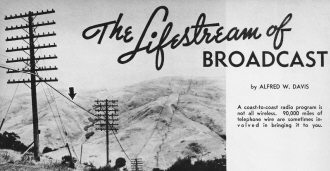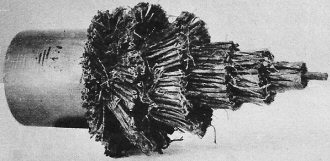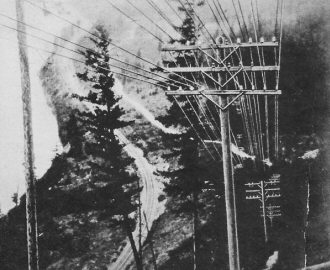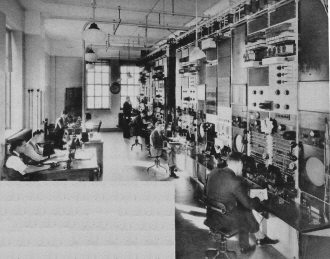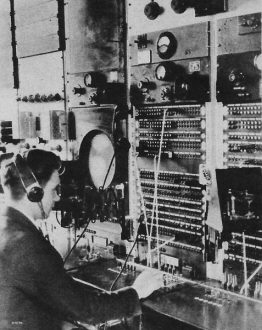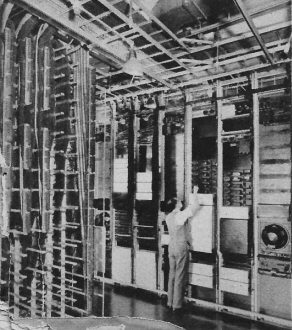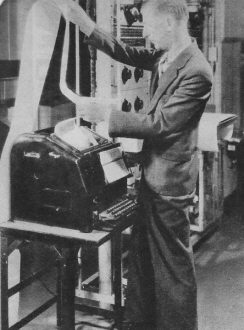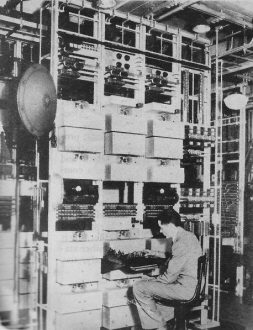The Lifestream of Broadcast Networks
|
|
Just as with modern day wireless and cellular network build-outs, the phenomenal costs involved in planning, implementing, maintaining, upgrading, and expanding coverage for wired networks of yore (as well as what remains of today's) was/is paid for by paying subscribers. Per this 1948 Radio News magazine article, American Telephone and Telegraph (AT&T) company's investment in network service at the time was well over $20,000,000, and that nearly a dozen basic networks regularly used 90,000 miles of wire. The included photo of the stripped end of a lead-sheathed multi-conductor cable is an indication of how complex and massive the effort was. A lot of engineering hours went into developing just the cables, let alone the citing and building of support towers, burial paths, relay and switching stations (and getting AC power to them), lightning protection, personnel and equipment access, and so much more. Aside from the lawsuits and court rulings regarding monopolistic and anticompetitive practices that eventually pervaded America's foundational communications companies, an immense credit is due them for launching the country to the forefront of the technology which play a vital roll in practically every other facet of technological advancement. The Lifestream of Broadcast Networks A coast-to-coast radio program is not all wireless. 90,000 miles of telephone wire are sometimes involved in bringing it to you. Across Wildcat Canyon; Berkeley, California, swings the cable ( arrow) which carries that Hollywood show to you in N.Y. by Alfred W. Davis Radio listeners in general do not know about, or give thought to, the great technical facilities which bring them their favorite programs with clock-like regularity. It is fairly safe to state that the public pictures little beyond the studio and microphones, in visualizing the wizardry that has made their radio entertainment possible. Without the "life stream," as these communication facilities can well be termed, broadcasting chains, or systems, could not exist. Our selection of programs in that event would be very definitely limited to the nearest local stations. Lacking its present value as an advertising medium to reach millions of people with simultaneous programs originating in one studio, radio could never have grown into the giant industry it represents today. It is the life stream of the broadcasting net work service that meets the coverage needs of sponsored commercial programs, and brings down the production costs of this great advertising media to reasonable and profitable levels. Stripped of technical verbiage, the life stream is a combination of radio science and telephone operations. The latter, with which we are concerned in revealing how our nationwide programs are made possible, can best be described as representing a gigantic pipe line system covering the entire nation, through which electric impulses flow like a stream of water to individual broadcasting stations, and which like a water line can be turned on or off at will. This service of facilities for program transmission is furnished to the broadcasting companies by the "Long Lines Department" of the American Telephone and Telegraph Company. A portion of the lead sheath stripped away on the transcontinental cable. Some of the conductors are for radio use only; others for telephone purposes. Clark River, Montana, section of the Minneapolis - Seattle link of Long Lines Department. The magnitude of this service becomes apparent when it is revealed that the company's investment in network service is well over $20,000,000, and that nearly a dozen basic networks regularly use 90,000 miles of wire, not including circuit mileage held in reserve for protection. The radio program, a concert for example, is rehearsed and is finally ready for broadcast. The music is picked up by microphones in a New York City studio, converted to electrical impulses of audio (sound) frequency and is carried on wires to a nearby room. As it passes through certain equipment there, the broadcasting company's engineer adjusts these electrical impulses to a certain degree of loudness [This adjustment is in terms of power or DB. Ed.] before they enter the telephone cable. At that point begins the telephone company's responsibility for "express service." Under the streets of New York the electrical impulses pass through the telephone cable downtown to the Long Distance Building at 32 Sixth Avenue. Here the General Control Office serves all the major networks. It receives complete daily program schedules from the broadcasting companies and relays them to a dozen telephone company control offices located throughout the nation. When the concert has passed through this control room its journey has only begun. It goes simultaneously to broadcasting stations in New England, Canada, the West, and South, travelling along the wire pipe lines at a speed of 186,000 miles per second. The electrical currents bearing sound waves have considerably more speed than strength. They become weaker the farther they go. At the same time the waves often become distorted due to a variety of intricate causes. When weakness and distortion happens to music, the notes coming from our loudspeaker give an effect of fuzziness, hollowness of tone, and other displeasing variations from the original presentation. Consequently, at intervals of about fifty miles along the long distance cable routes, the program passes through telephone company offices which are equipped to amplify the weak electrical currents and send them along, invigorated and restored to exactly the strength and form they had when they left the studio. At several points throughout the country there are control offices where equipment is installed to enable programs to be redistributed in various geographical directions over separate routes to still other radio stations. In recent years it has become an increasing practice on the part of broadcasters toward supplying certain sections of the country with selected types of programs, largely those of commercial sponsorship. There is also a growing trend toward picking up programs from studios at widely scattered points by other studios. All this complexity of the time element and geographical separation of stations involves swift reversals of the networks, as to the flow of the sound waves, and number of tie-ups on the one hand, and on the other the quick shifting of group stations from one network (or section of network) to another at frequent intervals. At Cleveland it may well happen that our particular program may be turned off on circuits serving six Midwest stations, because of local commercial broadcast commitments for the first half hour of the concert, but it may be turned on over these circuits for the last half hour as a sustaining program. In the case of a Southwest group the exact opposite may be the case, and they will put the first half hour of the concert on the air, and broadcast other programs during the last half hour period. The desires of both groups were of course known in advance, but the necessary switches and circuit arrangements must be made with split-second accuracy at the scheduled time. Meanwhile technical men at Cleveland and other telephone offices concerned are on the alert for any possible impairment in service. They. check by listening in over earphones, and are ready to switch to alternate routes always held available for any and all emergencies. Most of the routes east of the Mississippi are carried in cables which afford security against weather and other hazards, thereby meeting a most important requirement in network service. A long distance telephone cable incidentally is about the thickness of a wrist. Within its lead sheath are several hundred individual wires, each wrapped in wax paper to insulate it from the others. For radio program transmission purposes, since 1926, all such cables have been constructed to include several pairs of wires twice the size of those provided normally for telephone service. About 60,000 miles of such radio program wired-cable today serve the broadcasting companies. In addition there are many thousands of miles available for service when provided with amplifiers and. other equipment. In the vicinity of Omaha the program leaves the cables and proceeds over aerial wires supported by poles and cross arms. Ahead lay wide prairies, deserts, broad rivers, and high mountain ranges. Geography presents another problem to be solved by men, mechanisms, and money, before wire communication can be achieved. Four different long distance telephone routes cross that part of the continent lying between the Mississippi Valley and the West Coast. The Northern Transcontinental Line, through Minneapolis, Fargo, Billings, and Spokane parallels the Canadian Border. The Central Route runs via Omaha, Denver, and Salt Lake City, to San Francisco. Near the Mexican Border, the Southern Route passes through Dallas, El Paso, Tucson, and Yuma on its way to Los Angeles. A few hundreds of miles north of it is a fourth path to Los Angeles through Oklahoma City, Amarillo, Albuquerque, and Whitewater, California. Control switchboard with monitoring operator. Morse instrument gives orders, while earphones let him hear program transmitted. Rear view of panels in General Control Office in New York. At left is the interconnection frame; right, a speaker unit. All these routes carry broadcasting programs, as well as telephone conversations, and all are interconnected by North and South lines, making in combination a complicated pattern. After a journey of more than 3,000 miles the concert reaches a California broadcasting station exactly as it left Radio City, N. Y. At the same time the West Coast station sends it out into the ether, it is also being broadcast by scores of other stations in the nation. Simultaneously, too, other programs on other networks are being delivered to more broadcasting stations without any appreciable loss in fidelity and tone. To operate the circuits required for radio program transmission demands the specialized knowledge of hundreds of telephone employees. It requires that this manpower be strategically located on a nationwide front. Finally is demanded - both in spirit and in fact - the finest cooperation and coordination between all these individuals. Today, in our so-called mechanized age, it is often difficult for us to visualize the human equation. For our present purpose perhaps an outline in tabloid of a typical network day will serve to reveal the human side involved in this piping. Under normal. operation the various networks are in service sixteen hours daily, from 8:00 a.m. to 12 midnight, with overtime for early morning programs, or after midnight dance music. However, the network day of the personnel is 24 hours in length, starting at 1:30 a.m. Preparation for the start of service for another day must be completed prior to 7:00 a.m., at which time, let us say, a program must be transmitted over network B to 9 stations located in New England, New York, Ohio, Pennsylvania, Ontario and the District of Columbia. Before the circuit line-up and routine testing can start, certain general maintenance work must be done. For example amplifier tube tests are to be made at all offices between New York and Chicago from 1:30 a.m. to 2:30 a.m., and the various networks have been released for that period. When all such necessary preventive maintenance has been completed, each control office measures its section to be sure that the volume and fidelity of transmission is satisfactory. Similarly all the reserve transmission circuits in each section are tested by each control office. This completed, New York transmits testing power at various tones or frequencies over the entire network. The terminals and specified intermediate offices measure the amount of received power. Adjustments may be needed. During this midnight-to-morning period, each control office uses a teletypewriter circuit to report the service furnished, troubles experienced, and station comments for the preceding day. At 6:45 a.m. the New York studios are transmitting a test program for B network. During the next fifteen minutes, by means of a control telegraph wire, New York determines from each office feeding a radio station that satisfactory volume and quality is being received. At 7:00 a.m. the program begins all o.k. to each of the nine scheduled stations. Final arrangements are next made for the start of the day's service at 8:00 a.m. on the remainder of "B" network and the "A" network. Every day the broadcasting companies' schedules of operations showing switching cues, and program priority, for the following day are sent to each switching office. From this, each office prepares its switching schedule. Further to insure no slip-up in program switches, or priority placements, and to provide information on any change that may be suddenly made in the day's program, one broadcasting company furnishes a schedule covering the next three hours of program over the teletype-writer circuit at the beginning of each successive three hour period. With both mediums of information secured in advance the telephone company is fortified to meet almost any situation that may arise. Now let us follow through on some of the day's operations. At 8:00 a.m. Morning Meditations on network "A" starts the day, while during the same period, Morning Melodies is scheduled for the "B" network. Both programs, running for 30 minutes, and originating in New York. Since all the switching offices involved in handling both programs have had several hours to set-up the hookups to the individual stations broadcasting these programs, they receive no special attention. But what happens at 8:30 a.m.? International News is scheduled for the entire "B" network over a nationwide hook-up, coming from New York, while the "A" network with an equally wide distribution is carrying an Organ. Recital program originating in Chicago. The program order for one day sent to all telephone company offices from New York. It carries all network information for all services and is sent by teletype. The Danville, Illinois, repeater station. At regular intervals along the telephone wires; these stations restore the audio signal to its original studio strength. At the close of the 8:00 a.m. programs, pre-advised word cues are transmitted over both networks, by two broadcast announcers from the New York studios. Switch-men at four telephone company offices - Cleveland, Washington, Cincinnati and Kansas City - are listening on each network for these cues. In this case the cues come simultaneously. The coordination of the two programs by the broadcaster is perfect. As each switchman hears the cues, he notes the time to the second. They listen to the theme music following the closing announcement. It gradually fades. Twenty seconds after the cue they perform a switching operation which discontinues the former one-way, East-West routing of the programs on both networks. Next a second switching operation is performed by which the proper circuit connections are made to route both new programs, on one network flowing East-West, on the other West-East, direct to each station carrying these programs all over the country. All is ready for the programs to start. Now the switch-men stand-by for the opening announcements, for it still remains their duty to double-check that the switch has been properly executed. And so it goes f or each following fifteen minutes or half-hour - switching from one network to the other, realigning hook-ups, and coordinating all the wire facilities to the needs of the nation's broadcasting stations. So far the morning has been uneventful. But at 10:13 a.m., Cleveland flashes New York, "Network 'A' just failed." One man at New York aided by a telegraph wire, starts to locate the trouble, while another quickly substitutes a spare program circuit. Service is restored to all points west of Cleveland at 10:15:29 a.m. Chicago at 11:15 a.m. is advised by Denver that freezing weather prevails on the Central Transcontinentai Route around Truckee Pass, Nevada. Rain is turning to sleet, ice is forming on the wires, and the wind velocity is increasing. This word is passed on to New York. There may be trouble ahead, so notices are sent to offices along northern and southern transcontinental routes (routes which will not be affected by the severe weather) to be ready to line up program circuits at short notice. At 11:18 a.m. from a broadcaster's control room comes an emergency message stating that a flash political news story has just broken of great national importance, and service is desired to put it on the air from the Washington studio at 11:30 a.m. Every switching point involved is telegraphed this information and instructions at once. Promptly at 11:30 all the stations of the country on this chain receive this program satisfactorily, but by a slim margin, and at least ten telephone men in seven widely separated cities have worked with speed and perfect coordination to set up the required circuits. And so it goes on through the day and night, a continuous operation of distributing communications which eventually find their way to the ears of the nation's radio listeners via the air waves. After midnight the day's work ends and work starts immediately in preparation for the next day. Because of the exacting requirements inherent in the radio program service much new equipment has been designed and especially constructed, or existing telephone facilities suitably modified, exclusively for service to broadcasting companies. For instance, on our first journey we noted the amplification of a weakened current every fifty miles. This is made possible, in a very large part, by mechanisms known as repeaters. They are costly and differ from repeaters used in ordinary long distance telephony in several important respects. For example they will transmit a wider range of tone, and they introduce less distortion through the use of special transformers. Other special apparatus needed in furnishing this service includes equipment to interconnect sections of the network. The switching operations we looked over in our journey at Cleveland were a case in point. More than 60 other telephone offices throughout the country are similarly equipped. Some 260 more telephone offices contain special equipment for testing, adjusting, checking up, and rearranging the broadcasting networks to insure utmost efficiency. As early as 1915, Bell System engineers achieved radio telephone transmission from the United States to Paris and Honolulu. In these experiments, and in the subsequent expansion of radio telephony, which today encompasses virtually all the world, the technicians applied much that they had learned during more than half-a-century in the development of nationwide telephone service by wire. The storehouse of experience included intensive study of sound, particularly speech sounds; tireless research in transforming these sounds into electrical impulses, and transmitting them clearly over ever greater distances; development of apparatus for amplifying telephone currents which had lost strength over these long stretches of wire. In commenting on the tomorrow of radio the Bell System in one of its public statements points out, "Our ultimate goal, of course is the reproduction of music and speech in the listener's home, wherever located, so nearly equivalent to the actual program that there will be no audible difference. While keeping this objective in view the Bell System will endeavor to anticipate other requirements of radio broadcasting in the future."
Posted December 30, 2021 |
|

